Top News

October 16, 2013 Ryukyu Shimpo
The Okinawa Convention and Visitor Bureau (OCVB) held an Okinawa event in the 18th Busan International Film Festival “Asian Film Market” in Korea on October 7. OCVB staff have promoted the movies filmed in Okinawa and that it is an excellent place for filming movies. They have enhanced the support services for movie and TV crews in Okinawa to about 130 people in the filmmaking industry and screened the works (abridged versions) that it supported on location.
There was a talk show by Joey, a leading actor in the movie “Ryukyu Battle Royale,” which was supported by the OCVB in 2012, and Akihito Yagi, who also demonstrated karate at the event.
A bureau official said, “We want to attract overseas filmmakers to Okinawa and to advertise the appeal of Okinawa through the films they make.”
(English translation by T&CT, Hitomi Shinzato and Mark Ealey)
Go to Japanese

October 16, 2013 Ryukyu Shimpo
The vice chairperson of the Brazil Okinawa Kenjin-Kai Eiki Shimabukuro, Juliana Higa and others visited the Okinawa Prefectural Office on October 15. Higa received a “Miss Ryuso” award, given to those who look good in Ryukyuan traditional costume. They met Okinawa Governor Hirokazu Nakaima and asked him to take part in the ceremony marking the 100th anniversary of Okinawan immigration. The Campo Grande Okinawa Kenjin-Kai in Brazil will hold this ceremony in August 2014.
The group came to Okinawa to take part in the Naha Ozunahiki (Naha Tug-of-War) held from October 12 to 14.
Shimabukuro said, “There is also a ceremony in Bolivia next year to mark the 60th anniversary of immigration there. We will hold our Campo Grande ceremony on a grand scale around the same time.” Governor Nakaima replied, “We would like to attend these events.”
Juliana Higa, a university student majoring in international trade, said, “To help develop Brazil and Okinawa, I hope young people work on these events together.”
(English translation by T&CT, Lima Tokumori and Mark Ealey)
Go to Japanese
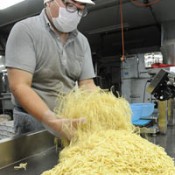
October 17, 2013 Ryukyu Shimpo
October 17 is Okinawa Soba Day. Until October 17, 1978, the Japan Fair Trade Commission did not allow Okinawa soba use the word soba in its name because the noodle does not contain buckwheat flour. However on that date, the Okinawa Fresh Noodles Cooperative and other organizations managed to get the commission to give permission to use the name Okinawa soba.
Okinawa soba restaurants held various events on October 17, so on the previous day noodle makers throughout Okinawa were busy producing soba for these events. Awase Soba which has been in business for 66 years, usually makes about 5,000 meal-units a day. The staff of the restaurant made 4,000 meal-portions of boiled noodles on October 15 and added another 2,000 portions of fresh noodles the next day. The president of the company, Seiko Takehara, said, “I would like people to enjoy Okinawa soba with various other foods such as chanpuru or Okinawan stir-fry dishes.”
(English translation by T&CT, Mark Ealey)
Go to Japanese

Go To Video
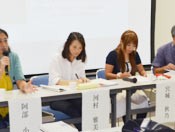
October 21, 2013 Ryukyu Shimpo
The Peace Studies Association of Okinawa held its annual meeting at the University of the Ryukyus in Nishihara on October 20. At the meeting, Takeshi Tokashiki, associate professor at the university explained that low-frequency sound generated by the MV-22 Osprey impacts upon human bodies. He said, “The problem is that the Japanese government let the U.S. military deploy the Osprey to Okinawa without testing the noise produced by the aircraft.” Tokashiki demanded that the governments regulate the noise pollution.
Masami Kawamura, director of the Citizen’s Network for Biodiversity in Okinawa, referred to dioxin and other harmful materials found inside barrels unearthed at a soccer ground on land in Okinawa City that had been returned by the U.S. military. She explained that the network examined the results of the examination that the central and city governments carried out, saying, “It is becoming clear that dioxin and other harmful materials inside the barrels have polluted the area.” She suggested that the central government should allow citizens to cross-check the results of surveys by public agencies.
Member of the Lepidopterological Society of Japan’s Nature Conservation Committee Akino Miyagi criticized the U.S. military for building helipads in Takae, Higashi Village. She said, “Everyone sees this as destruction of the natural environment.” Miyagi continued, “Politics make researchers hesitate about looking into the destruction of nature in the area. If more researchers focus on what is happening at Takae there will be more discoveries.”
The participants listened to reports from editors of local history books and testimonies from survivors of the Battle of Okinawa. They discussed how to convey people’s war experiences to future generations based on individual stories. A member of the Itoman Education Board, Yumiko Kashima, explained that the board has surveyed 37,000 survivors of the battle. She said, “We gathered facts little by little to find out what the battle was really like.”
Participants in the meeting actively exchanged opinions under the theme of peace movement and education.
(English translation by T&CT, Mark Ealey)
Go to Japanese
October 18, 2013 Ryukyu Shimpo
The Naha Port Comprehensive Logistics Center is moving ahead to provide services from April 2018. The facility will have advanced distribution support and processing capabilities, such as sorting cargo between arrival and departure from home and abroad. The air cargo logistics center has been making progress within the Naha Airport Area, but the development of Naha Port to enhance the seaport’s logistics capabilities has become an issue for the Okinawa economy. The business community also has requested that Okinawa Prefectural Government assist in developing Naha Port. With the construction project, international logistics hub projects in Naha will go into full swing both in the sea and the sky.
The Naha Port Authority has been jointly established by the Okinawa Prefectural Government and the cities of Naha and Urasoe. With the enhancement of the logistics center, the port authority expects to ship cargo more efficiently and to save on land transportation costs at Naha Port, where there are insufficient warehouse options. It is also possible that establishing a facility to process the goods will create new jobs.
According to the plan, the center will be a three-story building with a total floor area of about 3.5 hectares. The estimated cost to complete the project is about 7.4 billion yen. Making use of no-strings-attached state subsidies, the Okinawa Prefectural Government will cover 60 percent, Naha City 30 percent and Urasoe City 10 percent of the costs. The port authority will budget about 50 million yen for the basic design in FY 2013, of which 30 million yen is included in the Okinawa Prefectural Government’s supplementary budget in September. After creating the detailed design in FY 2014, the construction will start in FY 2015 and will be completed in three years in FY 2017.
The location for the center was designated in February as the International Logistics Hub Industrial Agglomeration Area Naha Port District. As a result, the companies moving in to the center will be able to receive preferential treatment such as corporate tax, custom duties and financial incentives leading to employment. The rent will be about 4,000 yen per month per 3.3 square meters.
(English translation by T&CT, Mark Ealey)
Go to Japanese

October 17, 2013 Hiroyuki Horikomi,correspondent of Ryukyu Shimpo
A kajimaya (97-year-old) celebration for Masao and Haru Sakuda from the Yonashiro district of Uruma was held at the local community hall on October 13. More than 200 relatives and neighbors celebrated with them. To commemorate their kajimaya, their second son Seitoku and his wife Keiko published a book about Masao and Haru, entitled Three-Legged Race, and gave copies to participants. The couple celebrated the day together, Masao with a smile on his from morning to evening and Haru winking at guests with a pinwheel in her hand.
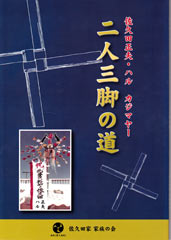
Their commemorative book: Three-legged Race.
Leaving home at 9:30 a.m., they slowly paraded around the Yonashiro district. They received the blessings from local people.
Sanshin and bo martial arts were performed at the community hall. Haru sang the children’s song Haru ga kita. In the afternoon, a large celebratory party was held at Castle Highlander in Uruma.
The commemorative book introduces the life stories of the two who survived the war.
They married in 1936, going on to have six sons and four daughters. The next year, Masao went to fight in China where he contracted malaria. He suffered from a hearing problem, but was able to return home safe. After the war, they made living working in the pork industry and supported the building of the community hall. The book also describes Haru’s services as the head of the Ladies Association and the first head of the Agricultural Cooperative in the community.
(English translation by T&CT, Megumi Chibana and Mark Ealey)
Go to Japanese
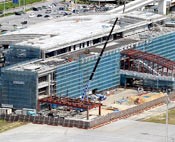
October 10, 2013 Ryukyu Shimpo
Naha Airport has decided to open the new Naha Airport International Terminal building, which is now under construction, on February 17, 2014. The company will close the current international terminal on February 16, 2014 in preparation for using that space as tarmac.
The new terminal will be located to the north of the domestic terminal. There will be a boarding bridge in the building to enable it to accept two medium-sized and four small planes. The four-story building will occupy 9,240 square meters and have a total floor space of 23,450 square meters.
The first floor will be the arrival lobby, the second floor the departure lobby and boarding area with the third floor appointed for immigration and customs. The fourth floor will have restaurants, retail and service stores.
(English translation by T&CT, Mark Ealey)
Go to Japanese
October 16, 2013 Ryukyu Shimpo
On October 15, the Department of Culture, Tourism and Sports of the Okinawa Prefectural Government announced the number of tourists who came to Okinawa in first half of fiscal 2013, that is, from April to September. The total number was up by 12.8 percent to 3,379,800 over the same period the previous year, representing a new high for the first half of a fiscal year. Tourists coming from other areas of Japan went up by 10.2 percent to 3,021,200, but those from overseas increased by 40.7 percent to 358,600.
Japanese people decided to travel to Okinawa instead of going overseas because of the relatively weak yen. The opening of New Ishigaki Airport and the start of services by low-cost carriers also contributed to expanding airline routes to Okinawa from in and outside of Japan. During this period, typhoons had little negative impact on Okinawa tourism.
The number of tourists from the Tokyo area increased by 9.4 percent to 1,486,500, and those from the Kansai area were up by 19 percent to 345,100. Those from the Nagoya area increased by 11.4 percent to 241,700 and from the Fukuoka area by 6.5 percent to 355,800. The number of Taiwanese tourists increased by 67.9 percent to 172,100 with 52,400 tourists coming from Hong Kong, up 42.8 percent. The number of South Korean tourists increased 2.9 times to 36,500. However, the number of tourists from mainland China decreased by 44.8 percent to 28,600 because of the Senkaku Islands dispute between China and Japan.
The increase in the number of airline routes from Okinawa to Taiwan and South Korea and the use of larger airplanes contributed to the larger numbers of inbound tourists.
A spokesman for the department said, “Okinawa competes with other areas of Japan as a tourist destination, but there is high demand for tourism in Okinawa. While domestic tourism figures have been steady, there has been an increase in meetings, incentive trips, conferences, and exhibitions involving Taiwan. We expect to be able to achieve our target of 6.3 million tourists in fiscal 2013.”
The number of tourists coming to Okinawa this September increased to 607,400, up 19.7 percent over the same month the previous year. This is the first time that the number has exceeded 600,000 in the month of September. Tourist numbers have now posted new highs each month for seven consecutive months from March and the numbers have exceeded those for the same month of the previous years for 12 consecutive months from October 2012.
The number of tourists from Japan increased by 15 percent to 546,200, with 61,200 tourists from overseas, up by 88.3 percent. The number of tourists from China increased by 35.7 percent to 5,700.
(English translation by T&CT, Mark Ealey)
Go to Japanese
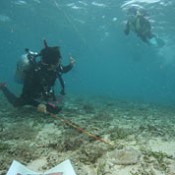
October 10, 2013 Tetsuya Nakajima, correspondent of the Ryukyu Shimpo
On September 28, about 40 residents took part in the Kumejima Island Underwater Cultural Heritage exhibition held in the sea off Oha Island. This event, held on the island for the first time and sponsored by the Agency for Cultural Affairs, aims to preserve and make use of the cultural assets that exist in the community.
After they listened to a lecture on underwater heritage delivered by experts from Kumejima Museum, the participants went on an observation tour in the water around Oha Island. This tour was supported by scuba divers and experts.
Split into two groups, one snorkeling and the other in a glass boat, they saw cultural assets such as old Chinese ceramics. The island makes it possible for visitors to see the underwater heritage items safely. Kumejima Island was a stopping point between China and Ryukyu during the period of the Three-Kingdoms known as the Sanzan and the Kingdom of Ryukyu. At the bottom of the sea off Kumejima, it is known that there are many old ceramics that trading vessels had carried. One of the participants on the tour said, “It was very impressive to be able to see such precious underwater heritage with my own eyes.”
(English translation by T&CT, Hitomi Shinzato and Mark Ealey)
Go to Japanese
October 12, 2013 Ryukyu Shimpo
On October 11, the Okinawa Prefectural Assembly unanimously adopted a written statement of opinion seeking a peaceful resolution to the matter of Chinese Coast Guard ships repeatedly intruding into Japanese territorial waters around the Senkaku Islands. The assembly also unanimously adopted a written statement of opinion seeking a review of two fisheries agreements, one between Japan and Taiwan and the other between Japan and China.
The assembly accepts that the Senkaku Islands are unmistakably a part of the territory of Japan, but stated that Okinawans are concerned about the territorial issue. They said that the dispute is damaging the friendly relations Okinawa has developed with China through historical exchange.
The assembly requests that the government enter into peaceful and calm diplomatic negotiations with China to resolve the issue. Referring to the fishery agreements between Japan and Taiwan, it strongly criticized the government for sacrificing Okinawan fishermen for the sake of Japanese diplomacy. About the collision in September between a Yaeyama fishing boat and Taiwanese boat, the assembly stated that “our concerns became reality. ” It wants a review of the extent of the waters where the laws and regulations do not apply to Taiwanese ships, and to create a fund to deal with accidents with Taiwanese vessels.
(English translation by T&CT, Mark Ealey)
Go to Japanese

October 12, 2013 Ryukyu Shimpo
The Okinawa City Office has reproduced the scene of the Koza Riot in 1970 using 3D computer graphics. The riot occurred in what was then Koza City (now Okinawa City) in 1970, when Okinawa was controlled by the U.S. military. From this month the city is providing a free application program that views the riot scene back in those days. This app aims to help tell the postwar history of Okinawa to the people, including students on school trips from other prefectures. It is entitled “The
Koza riot- the night that Okinawan ‘sadness and anger’ was set alight.”
The riot broke out on National Highway No. 330 and at Kadena Air Base Gate 2 Street in the early morning of December 20 in 1970, in the wake of a car accident involving U.S. military personnel. The disturbance calmed down around dawn that day.
Protesting against the suppression of human rights such as sex crimes and violent incidents involving U.S. troops under the rule of the U.S. military, thousands of angry residents overturned and burned about 80 cars of U.S. personnel.
Using photographic material from the time, the application uses 3D to cover the riot scene, including seven locations in the city where U.S. cars were burning. Users are able to see the street in the city, including roads, buildings and advertising displays of the time. They are able to view the scene reproduced realistically from all directions (360 degrees).
As users approach the scene shown on a map in the application about 20 photographs taken during the riot appear.
This app is available for free from the app site for use on all tablet PCs and smartphones.
It includes documents that summarized the commentaries and articles on the postwar history of the Okinawa City. The city intends to attract more school trips to Okinawa City by using this app, cooperating with the Okinawa Convention & Visitors Bureau and the Okinawa Prefectural Government.
Ryoichi Yonamine, deputy chief of the city’s Culture and Tourism Division, said, “We are using this app to train volunteer guides and want to provide a place where tourists and students on school trips can learn about our post-war culture.”
(English translation by T&CT, Mark Ealey)
Go to Japanese










 Webcam(Kokusai Street)
Webcam(Kokusai Street)


